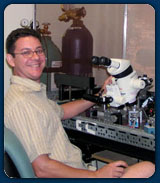
Michael R. Markham
Case-Hooper Associate Professor & Assistant Chair, Biology Richards Hall 410 & 411A 405-325-6760 markham at ou dot edu https://www.michaelmarkham.net Ph.D., Psychology - University of New Mexico, 1994RESEARCH:
My laboratory studies how ion channels, hormones, and behavior interact in a vertebrate communication system. We pursue this goal in a unique and powerful model organism, weakly electric fish. These fish image their world and communicate by generating electric fields in the surrounding water and detecting minute distortions of their electric fields. The electric fields are generated by the discharge of a specialized electric organ, and each electric organ discharge (EOD) is produced by the simultaneous action potentials of specialized cells within the electric organ, known as electrocytes. Electric fish are specialists in both the modulation and precise regulation of action potential waveform, making them ideal model organisms for exploring the biochemical and biophysical control of excitable membrane physiology where real-time changes in ion channel activity have direct and immediate effects on behavior. Sex steroids organize sexual dimorphism and shape plasticity in the electrocyte action potentials, and peptide hormones regulate rapid changes in the ionic currents that shape the electrocyte action potential, producing rapid modulations of EOD waveform in in response to circadian cues and immediate social conditions. Our work focuses on investigating the cellular and ionic mechanisms of EOD generation and plasticity, the regulation of electrocyte ion currents by steroid and peptide hormones, as well as the behavioral consequences of EOD waveform modulations.
Selected Publications:
Saenz, D. E., Gu, T., Ban, Y., Winemiller, K. O., and Markham, M. R. (2021) Derived loss of signal complexity and plasticity in a genus of weakly electric fish. J. Exp. Biol. 224, jeb242400.
Nourbakhsh-Rey, M. and Markham, M. R. (2021) Leptinergic regulation of vertebrate communication signals. Integr. Comp. Biol. 61: 1946-1954.
Markham, M. R. (2019) Biophysical basis of electric signal diversity, in: Carlson, B. A., Sisneros, J. A., Popper, A. N., and Fay, R. R. (eds.), Electroreception: Fundamental Insights from Comparative Approaches. Springer International Publishing, Cham (Switzerland), pp. 125-161.
Swapna, I., Ghezzi, A., York, J. M., Markham, M. R., Halling, D. B., Lu, Y., Gallant, J. R., and Zakon, H. H. (2018) Electrostatic tuning of a potassium channel in electric fish. Current Biology 28: 2094–2102.
Joos, B., Markham, M. R., Lewis, J. E., and Morris, C. E. (2018) A model for studying the energetics of sustained high frequency firing. PLoS One 13(4): e0196508.
Markham, M. R., Ban, Y., McCauley, A. G., and Maltby, R. (2016) Energetics of sensing and communication in electric fish: A blessing and a curse in the anthropocene? Integr. Comp. Biol. 56: 889-900.
Sinnett, P. M. and Markham, M. R. (2015) Food deprivation reduces and leptin increases the amplitude of an active sensory and communication signal in a weakly electric fish.. Horm. Behav. 71: 31-40.
Ban, Y., Smith, B. A., and Markham, M. R. (2015) A highly polarized excitable cell separates sodium channels from sodium-activated potassium channels by more than a millimeter.. J. Neurophysiol. 114: 520-530.
Markham, M. R. and Zakon H. H. (2014) Ionic mechanisms of microsecond-scale spike timing in single cells. J. Neurosci. 34: 6668-6678.
Lewis, J. E., Gilmour, K. M., Moorhead, M. J., Perry, S. F., and Markham, M. R. (2014) Action potential energetics at the organismal level reveal a trade-off in efficiency at high firing rates. J. Neurosci. 34: 197-201.
